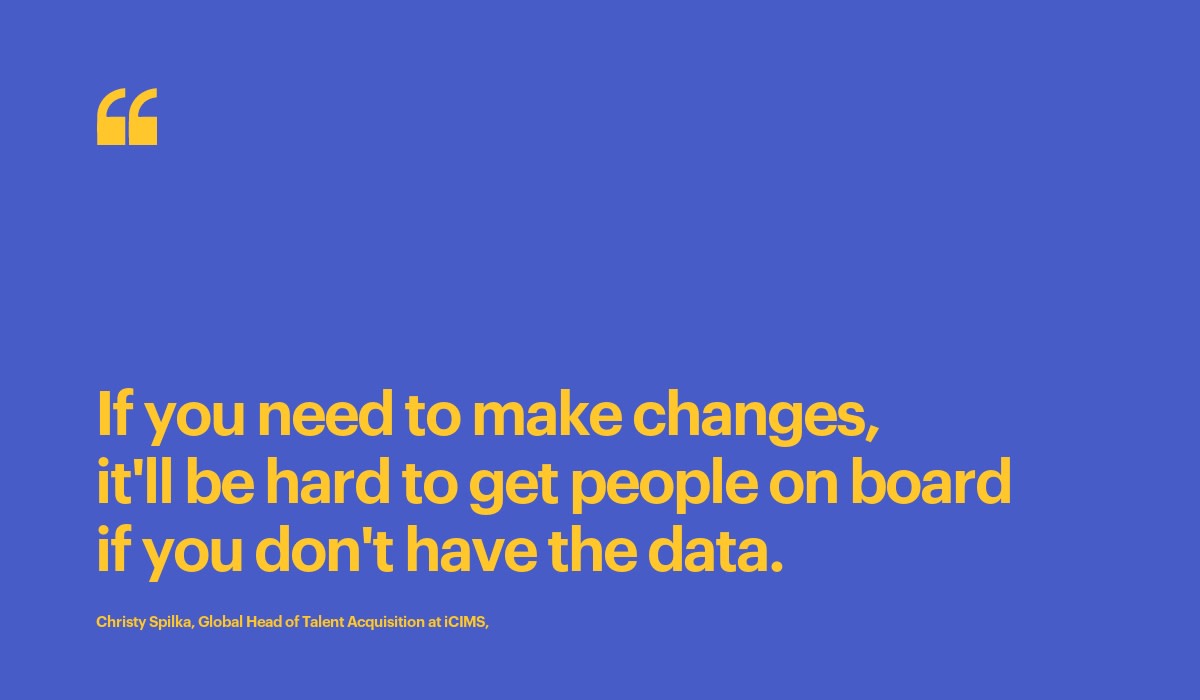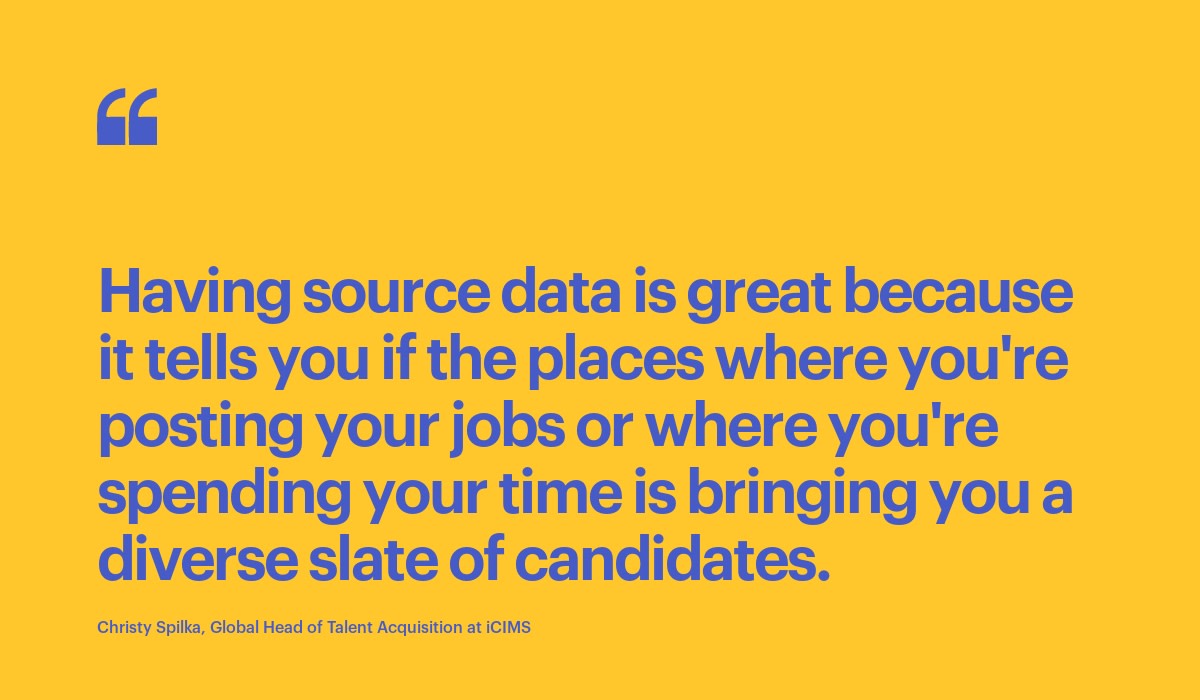How to Use Data to Recruit Smarter
Hear from Christy Spilka, Global Head of Talent Acquisition at iCIMS, about the future of recruitment and talent acquisition.

Visier spoke with Christy Spilka, a talent acquisition leader, writer, speaker, and the Global Head of Talent Acquisition at iCIMS. With nearly 20 years of experience in this space, Christy believes that “talent fuels organizational growth. The way that we find, select, and acquire top talent determines growth potential. My passion and expertise is building talent acquisition departments that serve as a competitive differentiator.” We sat down with Christy to talk about her talent acquisition philosophies, as well as the ways people analytics impact recruitment and talent acquisition.
Why get started with people analytics for talent acquisition, Christy?
Talent acquisition (TA) is continually evolving as a strategic partner to the business, especially as we’ve been able to automate a lot of talent tasks that used to be manual and time-consuming. This has allowed talent acquisition to make a shift into a more strategic talent adviser role. Access to more data means we’re able to make more informed decisions for the business. We can use data to drive decisions and have important conversations with other stakeholders in the business.
Ultimately, data tells your story and that’s why you need to get started with people analytics.
What are the most important TA metrics to an HR leader or CHRO?
You hear a lot about high-level metrics like time-to-fill and cost-per-hire. These are just a couple of examples of standard metrics in the industry. But there are many other metrics that are critical. I believe that the most important metrics are the ones impacting the standard high-level metrics.
For example, if you’re looking at time-to-fill, yes, that’s a great metric. But, what is contributing to your time-to-fill? I like to use what I call the “five layers of why.” I go one layer deeper, then another, then another…and, well, you get the idea. I dig deeper into that data. Why is my time-to-fill at 60 days for example? You also need to dissect that across different areas of the business. Maybe your sales time-to-fill is a lot higher than your tech hiring. Why is that?
Finding where that is happening in the process, reviewing the process from start to finish, and pulling all of that data until you can start to see what’s happening (and why) will help uncover that story.
Another impactful metric to analyze is the interview-to-hire conversion rate. If you have managers who are conducting interviews and only 40% of them are qualified, ask why. What should “good” look like? If 40% is not considered good for your organization, then why is that happening? Do you have an issue where TA and the hiring manager need to better align? Did TA not have a good enough understanding of the role so we’re not sending the right people? Maybe the hiring manager is looking for something different that they didn’t share in that initial discussion.
The key is that you can’t effectively solve for the root of the problem if you don’t have the data—and you’re going to have an especially hard time getting others on board when you want to make changes.
If you need to make changes, it’ll be hard to get people on board if you don’t have the data.

How do you think people analytics can make TA more powerful?
Leveraging people analytics to guide your TA strategy will help you and your team become a more strategic and trusted partner to the business. If you’re bringing data to the conversation, it’s very hard to argue with that.
People analytics allows you to bring data into TA in a way that answers important questions. For example, why you’re having a hard time filling a particular position. It also helps you to get the investment that you might need. So, if you’re a TA leader and you need additional staff, the best way to go about that is to share the data and be able to predict what type of outcomes you could achieve if you make that investment.
If you could tell people to track one thing when managing TA so they could do analytics later, what would it be?
First, take care to consider any reporting that you may need later with every change you make in your system. There may be a data point you’re not using, and you’re tempted to get rid of it. When I’m making any changes, I consider, am I going to want to report on this later? How can I make this easier to report on when I’m configuring my systems?
What would you say to someone who said that their TA data was too messy or incomplete for analytics?
Just get started. I’ve had many moments in my career where I needed data for something, and it wasn’t yet automated. So what I would do is have the team start manually. Start making the plan for how you’re going to automate that going forward or clean up your data so that you can get that data going forward.
How does people analytics for TA help when strategizing and improving diversity initiatives?
There are so many things here that you can look at. I think having the intersection of the TA data and the HR data in one place is really helpful. As a talent acquisition leader on the HR leadership team, I always like to understand all the talent metrics that are happening in an organization. Diversity, retention, all of the different things, help to inform our talent acquisition strategy and help us support the business.
From a recruiting specific example, having source data is great because it tells you if the places where you’re posting jobs or spending time is bringing you a diverse slate of candidates. And then, there are sourcing metrics. Are the places that we’re going to source effective in making sure that we have a diverse, full pipeline of candidates? Are there other places that we need to consider?

Any other words of wisdom when it comes to TA and people analytics?
As a recruiting leader, I find data to be one of the most powerful tools that we have in our arsenal to help us build a winning workforce. I like to empower my teams with data and analytics so they can make smarter, more informed decisions and achieve better results. Data is critical when talent acquisition partners are having discussions with other teams and departments on business needs—it completely shifts and guides the conversation.
Download The Big Book of People Analytics: Talent Acquisition to learn how people analytics plays a critical role in your talent acquisition strategy.
Get Outsmart content straight to your inbox
Subscribe to the People Insights Monthly newsletter for actionable insights and stories.
Subscribe now